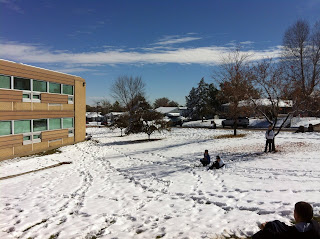I love the fall. I love the fall because I can see nature's timing; I can observe the closing down of plants and animals as they prepare for a long winter. The study of this timing in nature is called phenology. Observing the patterns of phenomena in nature works like a barometer; it provides natural scientists with a way to identify if a natural system is functioning in a healthy or unhealthy way.
I appreciate the meaning of the word when I look at it this way:
phen(onmena) + ology
Phenology is the study of this timing, of events in the natural world that happen with a season. Birds travel to the places they will find food, black bears search for any and all ways to fatten up before they enter a long period of sleep, and the leaves on the trees mark the turn in the seasons. In the spring, we observe the buds become leaves. There is a predictable timing to these events. In the fall, we observe the colorful display when the tree pulls inward to store its energy through the winter.
We can observe the natural world's phenomena in many places. Last week, at Achieve Academy, the Kindergartners went outside to observe the trees and found every color of fall. Reds, golds, browns, and greens are beginning to light up the west side of our school. The pine trees do not change colors. What do you think? Why do some trees in our school yard change and some do not?
Every class that has gone outside in the last week has noticed bumps and hard bubbles on the bottoms of leaves. What could that be? What will happen as we observe them in our classrooms over time?
Last week, a third grade Achieve Academy student observed another type of phenomena when he found a dragonfly on the sidewalk as he got off the bus. He noticed that the dragonfly was not moving away from all of the children's feet as they poured off of the buses, so he knelt down to pick it up. When he gently grasped the dragonfly by its tail, he noticed that the long, winged insect's body was soft. The reason that the dragonfly did not fly away was because it could not fly away. This amazing insect only recently became an adult. Maybe only minutes before the observant third grade student found it, the adult dragonfly lived under water, had a shorter abdomen, and instead of long, glass like wings, only had small nubs on its back. When the dragonfly in its nymph stage is ready to leave the water, it crawls to a stiff green plant, holds onto the stem or leaf with its six legs, then as its exoskeleton hardens, something incredible happens. Its back splits open, its head pulls out of its skeleton as it does a backbend to pull its front legs out of its former shell. Once its head is freed, it uses its front legs to grasp the plant and frees the back end of its body. When the dragonfly is finally completely free of its former nymph exoskeleton, it is also completely vulnerable. Until its new body hardens, it cannot fly or move. Its wings are soft and useless. But, it does not take long for the dragonfly to make this transformation complete. As its body hardens, its four wings go from shriveled to flat and straight, its body darkens, and its abdomen (the long thin part of its body) changes colors. Once airborne, the dragonfly is a fierce consumer of mosquitoes. It may live for years in the water as a nymph, but will only live for days or maybe weeks as an adult. What do you think happens to dragonflies as the weather turns colder and the days get shorter?
What phenomenon will you observe in the land around our school? What do you want to know about the timing and patterns of the natural world? This blog is a place for us to share our observations, our questions, and our thoughts. As we grow to understand the events in nature that happen right around us every day, we will be able to use our phenological record as a way to understand our community from its largest living parts like the trees, to the smallest living parts like dragonfly nymphs becoming adults. Let the venture begin!!

 On Thursday, October 27 at around 1:00, Mr. Munden's homeroom went outside to nature journal! It was very snowy outside with 6 inches of snow with some bare patches of grass showing. It just snowed the night before, but it melted that day because the sun came out and it was like 1,000 degrees!
On Thursday, October 27 at around 1:00, Mr. Munden's homeroom went outside to nature journal! It was very snowy outside with 6 inches of snow with some bare patches of grass showing. It just snowed the night before, but it melted that day because the sun came out and it was like 1,000 degrees!
